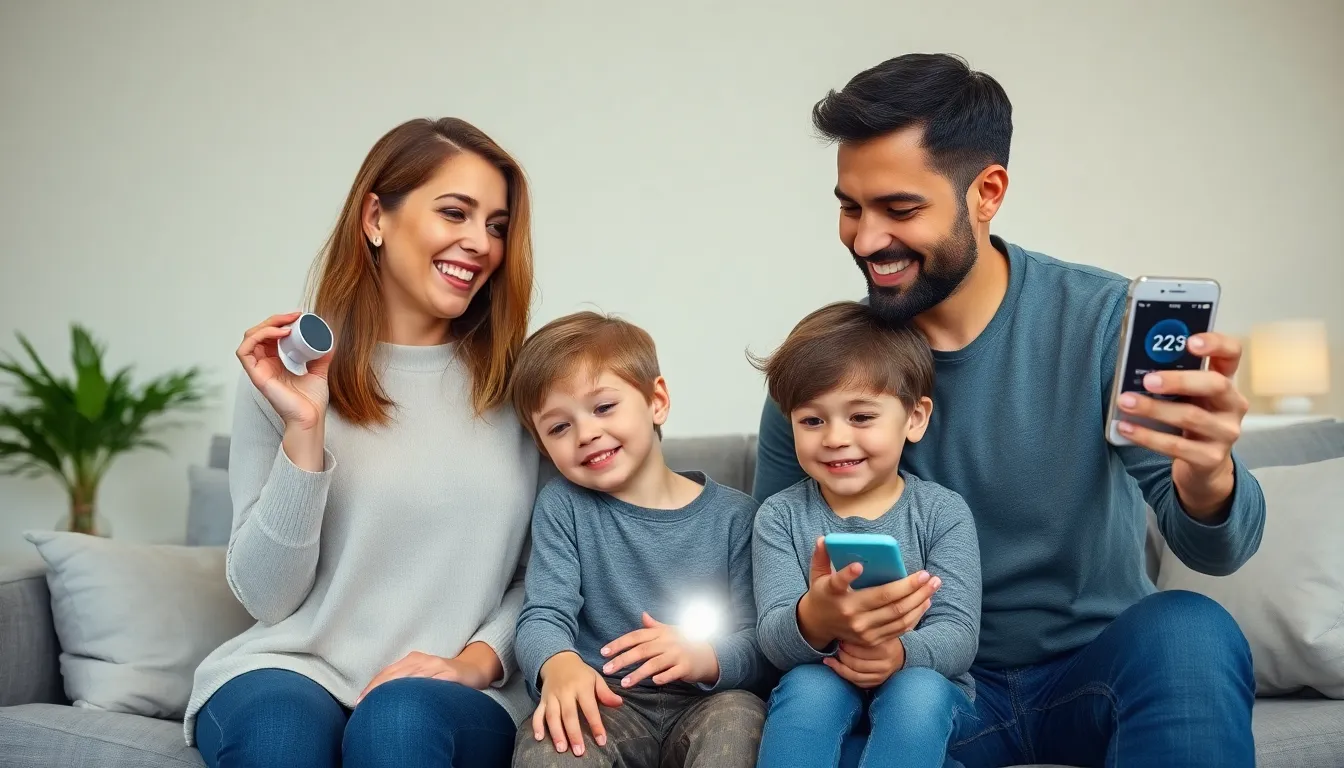Imagine walking into your home and having it respond to your every command. Voice-activated technology is transforming the way people interact with their living spaces, making homes smarter and more intuitive. From adjusting the thermostat to controlling lighting, these systems create a seamless experience that enhances daily life.
As this technology continues to evolve, it offers convenience and efficiency, allowing users to manage their homes with just their voices. With the rise of smart speakers and integrated devices, voice-activated homes are no longer a futuristic dream—they’re becoming a reality for many. Exploring this trend reveals not only the benefits but also the challenges that come with embracing a voice-controlled lifestyle.
Table of Contents
ToggleOverview of Voice-activated Home Technology
Voice-activated home technology enables users to control various aspects of their living spaces through verbal commands. This technology integrates smart devices such as speakers, lights, thermostats, and security systems, offering a seamless and efficient way to manage household functions. Users voice their preferences, allowing devices to respond automatically, creating a hands-free experience.
Smart speakers, like Amazon Echo and Google Nest, serve as hubs for these technologies. These speakers connect to other compatible devices within the home, ensuring centralized control. Users can adjust lighting, change temperatures, and even lock doors through simple voice commands. This setup enhances convenience, particularly for individuals with mobility limitations.
Voice recognition software plays a crucial role in this technology. Modern systems utilize advanced algorithms to understand and process natural language. They learn user preferences over time, improving response accuracy. The integration of artificial intelligence further refines this experience, granting users more control and personalization.
Despite numerous advantages, challenges exist. Security concerns arise about data privacy and unauthorized access to voice commands. Additionally, compatibility between various devices can pose issues for users seeking a cohesive system. Addressing these challenges remains essential for the long-term adoption of voice-activated home technology.
The growing demand for these systems reflects a shift toward smarter living. Research indicates a significant increase in households adopting voice technology, signaling its potential to redefine home automation. Embracing such innovations supports a more efficient, accessible lifestyle.
Benefits of Voice-activated Homes

Voice-activated homes offer numerous advantages that enhance daily living experiences. These benefits include improved convenience, greater accessibility, and increased energy efficiency.
Convenience and Accessibility
Voice-activated homes provide unparalleled convenience. Homeowners can control smart devices like lights, thermostats, and security systems with simple verbal commands, eliminating the need for physical interaction. This hands-free approach particularly benefits users with mobility limitations or those juggling multiple tasks, such as cooking or caring for children. Users can adjust settings, play music, or check the weather without using their hands. Additionally, the integration of voice recognition software allows devices to learn individual preferences, making interactions quicker and more intuitive over time.
Energy Efficiency
Voice-activated systems contribute significantly to energy efficiency. Users can program devices to operate during peak hours or set schedules based on daily routines. For instance, automated lighting can turn off when no one is in a room or adjust based on natural light availability. Smart thermostats can optimize heating and cooling settings, ensuring energy savings without sacrificing comfort. Research indicates that homes with voice-activated technology experience a reduction in energy consumption, enhancing sustainability efforts while lowering utility bills.
Key Components of a Voice-activated Home
Voice-activated homes rely on several essential components to create seamless automation and control. These components include smart speakers and hubs, as well as a variety of compatible devices and appliances.
Smart Speakers and Hubs
Smart speakers serve as the central control point within voice-activated homes. Devices like the Amazon Echo and Google Nest connect users to various smart technologies through voice commands. These hubs facilitate interactions with compatible devices, allowing users to manage lighting, climate, and security systems effortlessly. Smart speakers utilize advanced voice recognition software, which improves with use, offering a personalized experience. The compatibility of these hubs with multiple ecosystems enhances the overall efficiency of home automation by integrating diverse technologies, enabling a cohesive environment.
Smart Devices and Appliances
Smart devices and appliances play a crucial role in the voice-activated ecosystem. Common examples include smart bulbs, thermostats, locks, and cameras. Many smart appliances, like refrigerators and ovens, now feature voice control to perform specific functions easily. These devices connect to smart speakers or hubs, responding to commands for tasks such as adjusting room temperature or controlling lights from anywhere in the home. The convenience of voice-activated smart devices enriches user experience while improving energy efficiency by allowing for the precise management of power usage. Integration of various devices fosters a comprehensive home automation environment, meeting diverse user needs effectively.
Popular Voice-activated Home Systems
Voice-activated home systems have gained significant traction, with leading platforms offering innovative solutions for home automation. Below are three popular systems that dominate the market.
Amazon Alexa
Amazon Alexa serves as a versatile voice assistant designed to control smart home devices. It connects seamlessly with numerous compatible products, from smart lights to security cameras. Users can issue commands through devices like the Amazon Echo, which functions as a central hub for managing home automation. Alexa’s skills library expands continuously, allowing integration with various applications that enhance user experience, such as music streaming and reminders. Moreover, Alexa’s ability to recognize multiple voices permits personalized responses and tailored settings for different users.
Google Assistant
Google Assistant stands out for its advanced natural language processing capabilities. This system works with Google Home speakers and enables control of various smart devices within the home. It offers a wealth of information, answering questions and providing traffic updates, making it an intelligent companion for daily tasks. Google Assistant integrates with Google services like Calendar and Maps, allowing users to manage their schedules and navigate easily. Its compatibility with a wide range of third-party devices makes it a popular choice for smart home enthusiasts seeking extensive customization.
Apple HomeKit
Apple HomeKit emphasizes security and privacy while providing a harmonious ecosystem for smart home devices. It utilizes the Home app to enable users to control and monitor their devices, from lights to thermostats, all in one place. HomeKit’s strong focus on security involves end-to-end encryption for user data, ensuring privacy while controlling connected devices. Integration with Siri allows users to issue voice commands for hands-free operation. HomeKit’s compatibility with numerous certified accessories positions it as a go-to solution for Apple users looking to enhance their home automation experience.
Voice-activated home technology is reshaping how individuals interact with their living spaces. The ease of controlling devices through simple voice commands enhances everyday convenience and accessibility. As this technology continues to evolve and integrate into more households, its potential to streamline home automation becomes increasingly evident.
While challenges like security and compatibility remain, the benefits far outweigh the drawbacks. Homeowners are embracing this shift towards smarter living, enjoying improved energy efficiency and greater control over their environments. With advancements in voice recognition and smart device integration, the future of home automation looks promising.


